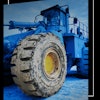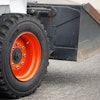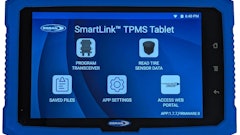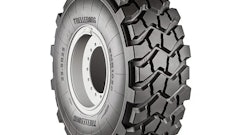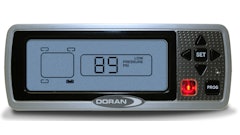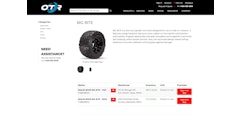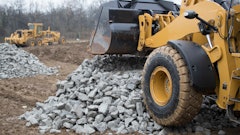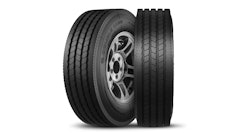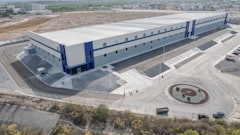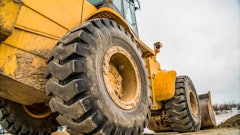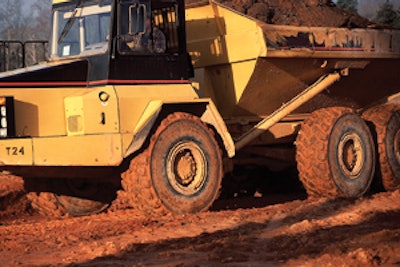
Careful haul road design and a well thought out maintenance plan are wise investments. "An efficient and well-planned haul road can reduce operating costs of most jobsites," says Mike Tolman, market segment manager - North America, Construction, Port and Industrial Tires, Michelin Earthmover Tires.
Haul roads should not be an afterthought. "The most common mistake for haul roads is lack of planning," says Tim Good, global customer account manager OTR tires, Goodyear. "It is not enough just to get between points A and B. Contractors must consider safety, efficiency and tire and equipment life. Haul-road design must consider the material used, road width, grade and crown, curve radius and super elevation."
You also need to consider the equipment that will use the haul road. "Sometimes when designing roads, the equipment that is going to be running on those roads is not taken into consideration — only the equipment being used to build the road," says Tolman. "The materials used to build the roads play a very important part, particularly when the sites are in rainy areas."
Tire choice is also critical. "The design of the haul roads needs to match up to the rubber compounds of the tires being used on a particular site," says Tolman. "For example, certain compounds are better suited to short hauls vs. longer hauls, and if used in the wrong application, the tires can be damaged to the point that they are no longer serviceable."
Every jobsite and type of haul road requires a unique approach. Consider the case for motor wheel scrapers. "Scraper haul roads are usually a short-term requirement and they are changed frequently during a job," says Good. "The top priority for a scraper operator is ‘don't spin the wheels'. Therefore, minimize grade or plan to shut down scraper operations during bad weather if the grades are steep. In addition, use a push dozer with a flat blade or a two-scraper push-pull arrangement when loading."
Don't over water
Construction jobsites tend to be around more populated areas where particulate emissions are closely monitored and fines for non-compliance can be steep. "So the tendency is to over water," says Roger Best, senior field engineer, Bridgestone Firestone Off Road Tire.
Water can actually be detrimental to tires working off-road. Standing water should be avoided. "The water acts like a lubricant," says Best.
It can also hide holes and rocks, which may damage the tires. "While water should be used for dust control, tires should not work in standing water," says Good. "Put simply, do not load or dump in standing water. If the loading area of the pit floods, pump it dry."
Also avoid continually spraying the roads using water trucks. "We recommend spot watering instead of continuous flooding of the roads," says Tolman. "Continuous watering tends to flush out and deteriorate the road base, which will require the site to resurface the road constantly. From a safety standpoint, too much water on the road makes it very slippery and particularly dangerous if the vehicles are coming downhill with a load."
When watering a haul road, a little driver training can go a long way. "The best way to water a haul road is to use an on/off pattern and let the tires carry the water from the wet areas to the dry," says Good. "For example, water trucks should spray 200 yds. of haul road, followed by 50 yds. left dry, followed by 200 yds. watered. In addition, operators should avoid two passes of the water truck without some drying time in between."
Design for drainage
Proper sloping of haul roads keeps them dry. "Crowning haul roads is key to keeping water from pooling," says Good. "Road crown of 3% is ideal. A crown of less than 3% allows the water to flow to low spots where tires can sustain damage and increased wear. Crowning that exceeds 3% causes uneven tire loads."
Many haul roads also have berms on the sides of the road. "Berms can prevent proper drainage, creating pooling on the road surface," says Best. "We see some sites where parts of the berm have been pushed back every couple hundred feet to allow for draining off the side of the road. Drivers should be cautioned to the openings in the berm to avoid running into them."
Keep grades to a minimum
Steep grades will reduce tire life. "Steeper grades can cause the tires to slip, and slippage reduces tire life," says Best. "So the lower the grade, the better."
The grades can change loading on the tires. "Hauling on steep grades causes a load to shift to the front or the rear of the vehicle, depending on which direction you are hauling the load," says Tolman. "If you are hauling the load down, you should pay special attention to the air pressure adjustment of the front tires and set them according to operating conditions. This compensation should be done only after consulting with your tire manufacturer representative to ensure the proper air pressure setting. When designing haul roads, try to avoid grades higher than 8% to reduce the effect of load transfer."
Good agrees, adding, "It is best to limit grades between 5% and 8% for improved tire traction and fuel economy. If steep grades are unavoidable, weather conditions will dictate when equipment may operate. Heavy downpours or snow on steep grades cause tire slip with corresponding rapid wear, loss of traction and possible safety issues."
Think through the curves
Tight curves should be avoided because they create additional wear on the tires. "If the work area is tight and can't be expanded, we recommend the operators lower speeds going through the curves to prevent excess load transfer on the tires," says Best. "But definitely, a larger radius curve allows the truck to run at a higher speed within the tire manufacturer recommendations, and helps reduce the load transfer on the tires."
Banking the corners can compensate for the curve radius and take stress off the tires. "If the roads are sloped or banked appropriately, it can greatly aid the turning radius of the vehicles," says Tolman.
It essentially boils down to using the laws of physics to your advantage. "Basically, the idea is that the truck can run through the curve at full speed, just like on a race track" says Best. "Elevate one side of the track and the load transfer isn't as great."
On a flat curve, more load is transferred to the outside of the tire. "It could be really bad if it is all transferred to the right front tire in a left curve," says Best. "You just add that much more overload condition to the tire. The load transfer will heat up the tire faster over time and create the opportunity for premature failure. If you run over a rock with that tire, it is more susceptible to damage."
Keep it clean
"Smooth roads and well-maintained loading and dump areas will yield positive returns," says Good. Consider data from hard-rock mine sites. "It is not unusual for 45% of the tires to be removed for cuts, 29% for impacts, 7% for worn treads and 18% for other conditions. If you can eliminate half of your cuts and impacts, tires removed for worn treads actually increase to 44%, and have a major impact on overall tire cost.
"Unfortunately, a cut or impact can lead to tire removal when it is 1% worn or 90% worn," he continues. "These early hazard failures are particularly costly, due to equipment downtime for tire repair or a search for a replacement."
Much of the damage occurs in load and dump areas. ""Usually, 80% of the rock cuts happen in dumping or loading areas," says Best.
Excessive speed contributes to the problem. "By slowing down before entering loading and dumping areas, operators can avoid spillage from road undulations that result in excess tire deflections," says Good.
"In the dump areas, when you slow down as you approach, you can make a wider radius turn, which reduces spillage and the possibility of riding on the shoulders of the tires," says Tolman. "This reduces the wear and tear and prolongs their life."
By approaching at a slower speed, you are also better able to navigate rocks or debris in the area. "At this point, it is very important not to damage the tires.," Tolman states. "The tires have been working very hard to carry the load and have probably reached their maximum temperature, making them more susceptible to damage."
Optimize width
Oftentimes, the jobsite dictates the practical width of the haul road. But when it is possible, wide haul roads can increase productivity. "It is a definite advantage to have a road that is at least three times as wide as your biggest truck," says Best. "So if you have a 15-ft.-wide truck, you need at least a 45-ft. road. That way, you have two-way direction plus a buffer in the middle and on each side to pass. You also create a lane so that when the grader is going by, the trucks can still pass."
Many sites only have room for a lane and a half. "Their solution is to create passing lanes," says Best. "The problem with that is you are really slowing up your production because you have a guy waiting for another guy to pass."
The human factor
With the shortage of tires, haul road design and maintenance are crucial. "It's also important that all operators and employees understand their roles in maximizing tire life," says Good. "Companies need to educate their workforce on tire maintenance and the keys to extending tire life. A cut or flattened tire can have a major impact on whether a piece of equipment becomes inoperable, particularly during a global tire shortage where replacement tires aren't readily available."


